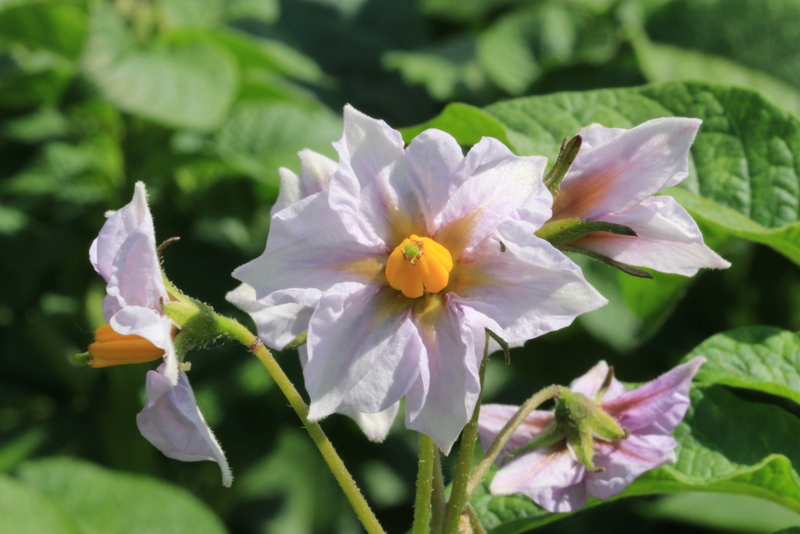Potato Extension
Timely information for potato growers in North Dakota and Minnesota.
Documentation for Suspected Spray Drift
Minnesota 2012 Certified Seed Potato Crop
In 2012, 6,081 acres of seed potatoes were certified in Minnesota, which was down from the 6,975 acres certified in 2011. The Norland variety which includes the Red and Dark Red selections has the largest combined acreage with 1,496 acres and Russet Burbank is second with 1,353 acres. Other notable red varieties include Dakota Rose with 390 acres, Red Pontiac with 311 acres, Red Lasoda with 315 acres and Chieftain with 273 acres. The three major white varieties are Dakota Pearl with 346 acres, Kennebec with 319 acres and CalWhite with 151 acres. Overall 91 varieties and 18 numbered clonal selections were certified in 2012.
With a warmer than average winter and very little snow cover, growers were able to start planting earlier than normal and finishing approximately 1 – 2 weeks ahead of normal. The spring started out with ideal growing conditions. Summer growing conditions, however were not so ideal. Most of the summer was hot and extremely dry in most of our growing areas. This did play toll on yields however; growers were surprised and pleased with their yields giving the dry conditions. With harvest approaching, some of the growers, especially the ones growing reds for the fresh market, delayed harvest due to lack of moisture that was causing some bruising and skinning of the potatoes. Most of the seed acres were harvested before the rain and an early snow that came in October, however approx. 80 acres of seed did not get harvested before the below freezing temperatures set in.
A few growers have started shipping seed to the southern states and also exporting seed to Uruguay and the quality has been very good.
The post-harvest winter test plot has been planted in Hawaii. This test is vital to keep viruses, such as Potato Virus Y and Potato Leafroll, at an economic threshold that’s acceptable within industry. This is a mandatory requirement for all potatoes entering the certification process in all states. Readings will take place the first three weeks of January with the results sent out to the seed growers by the end of month.
Michael Horken, Minnesota Department of Agriculture
North Dakota Seed Potato Crop in 2012
Growing conditions for the seed potato crop in North Dakota were generally favorable, but harvest conditions were less so, being too dry in September and too wet in October. Seed potatoes generally were harvested before the rains kept coming. “Dry land” potatoes were actually in dry land. Early planting, dry and warm conditions were favorable for insects, but kept late blight at bay. The early planting and warm growing season for the seed potato crop should result in early emergence and growth. Large fields of homogenous rich soil also create conditions for a crop that is uniform with much vigor.
Varieties are changing in North Dakota. Clearwater Russet, Altura Russet and Blazer Russet have disappeared altogether. Ranger Russet, Umatilla Russet and Russet Burbank are holding their own. In 2012 14,446 acres of seed potatoes were certified, which makes North Dakota the second largest seed potato producing state in the country. Norland selections covered over 5,000 acres, followed by Russet Burbank, Dakota Pearl, Umatilla Russet, Red LaSoda and Ranger Russet.
The greatest increase in the last five years has been the Dark Red selection of Norland that more than doubled to over 3,500 acres. Dakota Pearl also comes out as a winner with doubling of the acreage compared to five years ago to over 1,500 acres. The varieties Prospect, the Norkotah strains, Bannock Russet, Modoc, Colorado Rose, Dakota Crisp all more than doubled their acreage in the last five years. GoldRush, Shepody and Yukon Gold have lost acreage over the same period in the state. North Dakota produces several new varieties in smaller acreages, such as: Harley Blackwell, Lady Claire and Monticello for chipping, or french friers as Alpine Russet and Teton Russet, but most varieties for the fresh market such as Colorado Rose, Dakota Rose and yellow flesh varieties such as Melody, Sierra Gold, Agata, Milva, Satina, Augusta, Ambra, Romanz and Bellarosa.
North Dakota seed potato sources can be found in the ND Seed Potato Directory, which is available at the North Dakota State Seed Department, PO Box 5257, Fargo, ND 58105-5257, or by phoning 701 231 5400, or on the internet at www.ndseed.com.
Willem Schrage, ND State Seed Department
Late Blight Info
Late Blight Information and Resources
- NDAWN Potato Late Blight Severity Values
- Late Blight in Potato
- NDSU Potato Pathology
- USA Blight
- Late Blight: A Plant Disease that Impacts the Community
- American Phytopathological Society Late Blight Site
Blightline
- North Dakota 1.888.482.7286
- Michigan State 1.888.379.9012
- University of Idaho 1.800.791.7195
- Washington State University 1.800.984.7400
- Oregon State University 1.800.705.3377





